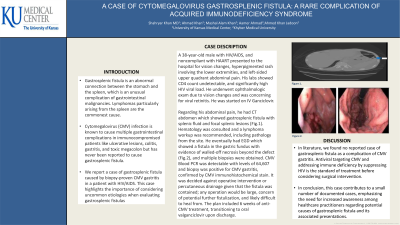Monday Poster Session
Category: Stomach
P3408 - A Case of Cytomegalovirus Gastrosplenic Fistula: A Rare Complication of Acquired Immunodeficiency Syndrome
Monday, October 28, 2024
10:30 AM - 4:00 PM ET
Location: Exhibit Hall E

Has Audio
- SK
Shahryar Khan, MD
University of Kansas
Overland Park, KS
Presenting Author(s)
Shahryar Khan, MD1, Ahmad Khan, MBBS2, Mashal Alam Khan, MBBS3, Aamer Ahmad, MBBS4, Ahmed Khan Jadoon, MD5
1University of Kansas, Overland Park, KS; 2Khyber Teaching Hospital, Nowshera, North-West Frontier, Pakistan; 3Khyber Medical University, Overland Park, KS; 4Khyber Medical University, Peshawar, North-West Frontier, Pakistan; 5The Aga Khan University Hospital, Karachi City, Sindh, Pakistan
Introduction: Gastrosplenic fistula is an abnormal connection between the stomach and the spleen, which is an unusual complication of gastrointestinal malignancies. Lymphomas particularly arising from the spleen are the commonest cause. Cytomegalovirus (CMV) infection is known to cause multiple gastrointestinal complications in immunocompromised patients like ulcerative lesions, colitis, gastritis, and toxic megacolon but has never been reported to cause gastrosplenic fistula. We report a case of gastrosplenic fistula caused by biopsy-proven CMV gastritis in a patient with HIV/AIDS. This case highlights the importance of considering uncommon etiologies when evaluating gastrosplenic fistulas.
Case Description/Methods: A 38-year-old male with HIV/AIDS, and noncompliant with HAART presented to the hospital for vision changes, hyperpigmented rash involving the lower extremities, and left-sided upper quadrant abdominal pain. His labs showed CD4 count undetectable, and significantly high HIV viral load. He underwent ophthalmologic exam due to vision changes and was concerning for viral retinitis. He was started on IV Ganciclovir. Regarding his abdominal pain, he had CT abdomen which showed gastrosplenic fistula with splenic fluid and focal splenic lesions (Fig.1). Hematology was consulted and a lymphoma workup was recommended, including pathology from the site. He eventually had EGD which showed a fistula in the gastric fundus with evidence of walled-off necrosis beyond the defect (Fig.2), and multiple biopsies were obtained. CMV Blood PCR was detectable with levels of 64,607 and biopsy was positive for CMV gastritis, confirmed by CMV immunohistochemical stain. It was decided against operative intervention or percutaneous drainage given that the fistula was contained; any operation would be large, concern of potential further fistulization, and likely difficult to heal from. The plan included 6 weeks of anti-CMV treatment, transitioning to oral valganciclovir upon discharge.
Discussion: In literature, we found no reported case of gastrosplenic fistula as a complication of CMV gastritis. Antiviral targeting CMV and addressing immune deficiency by suppressing HIV is the standard of treatment before considering surgical intervention. In conclusion, this case contributes to a small number of documented cases, emphasizing the need for increased awareness among healthcare practitioners regarding potential causes of gastrosplenic fistula and its associated presentations.

Disclosures:
Shahryar Khan, MD1, Ahmad Khan, MBBS2, Mashal Alam Khan, MBBS3, Aamer Ahmad, MBBS4, Ahmed Khan Jadoon, MD5. P3408 - A Case of Cytomegalovirus Gastrosplenic Fistula: A Rare Complication of Acquired Immunodeficiency Syndrome, ACG 2024 Annual Scientific Meeting Abstracts. Philadelphia, PA: American College of Gastroenterology.
1University of Kansas, Overland Park, KS; 2Khyber Teaching Hospital, Nowshera, North-West Frontier, Pakistan; 3Khyber Medical University, Overland Park, KS; 4Khyber Medical University, Peshawar, North-West Frontier, Pakistan; 5The Aga Khan University Hospital, Karachi City, Sindh, Pakistan
Introduction: Gastrosplenic fistula is an abnormal connection between the stomach and the spleen, which is an unusual complication of gastrointestinal malignancies. Lymphomas particularly arising from the spleen are the commonest cause. Cytomegalovirus (CMV) infection is known to cause multiple gastrointestinal complications in immunocompromised patients like ulcerative lesions, colitis, gastritis, and toxic megacolon but has never been reported to cause gastrosplenic fistula. We report a case of gastrosplenic fistula caused by biopsy-proven CMV gastritis in a patient with HIV/AIDS. This case highlights the importance of considering uncommon etiologies when evaluating gastrosplenic fistulas.
Case Description/Methods: A 38-year-old male with HIV/AIDS, and noncompliant with HAART presented to the hospital for vision changes, hyperpigmented rash involving the lower extremities, and left-sided upper quadrant abdominal pain. His labs showed CD4 count undetectable, and significantly high HIV viral load. He underwent ophthalmologic exam due to vision changes and was concerning for viral retinitis. He was started on IV Ganciclovir. Regarding his abdominal pain, he had CT abdomen which showed gastrosplenic fistula with splenic fluid and focal splenic lesions (Fig.1). Hematology was consulted and a lymphoma workup was recommended, including pathology from the site. He eventually had EGD which showed a fistula in the gastric fundus with evidence of walled-off necrosis beyond the defect (Fig.2), and multiple biopsies were obtained. CMV Blood PCR was detectable with levels of 64,607 and biopsy was positive for CMV gastritis, confirmed by CMV immunohistochemical stain. It was decided against operative intervention or percutaneous drainage given that the fistula was contained; any operation would be large, concern of potential further fistulization, and likely difficult to heal from. The plan included 6 weeks of anti-CMV treatment, transitioning to oral valganciclovir upon discharge.
Discussion: In literature, we found no reported case of gastrosplenic fistula as a complication of CMV gastritis. Antiviral targeting CMV and addressing immune deficiency by suppressing HIV is the standard of treatment before considering surgical intervention. In conclusion, this case contributes to a small number of documented cases, emphasizing the need for increased awareness among healthcare practitioners regarding potential causes of gastrosplenic fistula and its associated presentations.

Figure: Fig.1 CT Abdomen Pelvis with Gastrosplenic fistula, Fig.2 EGD showing Gastrosplenic fistula in gastric fundus.
Disclosures:
Shahryar Khan indicated no relevant financial relationships.
Ahmad Khan indicated no relevant financial relationships.
Mashal Alam Khan indicated no relevant financial relationships.
Aamer Ahmad indicated no relevant financial relationships.
Ahmed Khan Jadoon indicated no relevant financial relationships.
Shahryar Khan, MD1, Ahmad Khan, MBBS2, Mashal Alam Khan, MBBS3, Aamer Ahmad, MBBS4, Ahmed Khan Jadoon, MD5. P3408 - A Case of Cytomegalovirus Gastrosplenic Fistula: A Rare Complication of Acquired Immunodeficiency Syndrome, ACG 2024 Annual Scientific Meeting Abstracts. Philadelphia, PA: American College of Gastroenterology.
